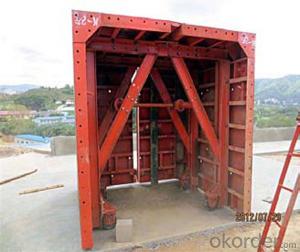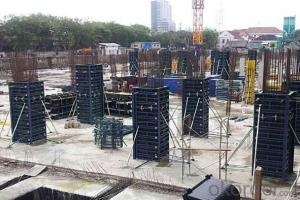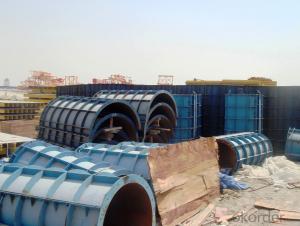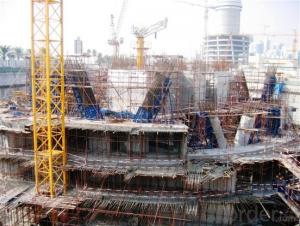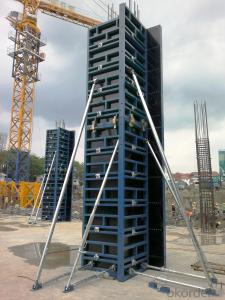Steel Formwork System Fromwork Accessories
- Loading Port:
- Tianjin
- Payment Terms:
- TT OR LC
- Min Order Qty:
- 3 m.t
- Supply Capability:
- 1000 m.t/month
OKorder Service Pledge
OKorder Financial Service
You Might Also Like
Steel Formwork System Fromwork Accessories
Product pictures:
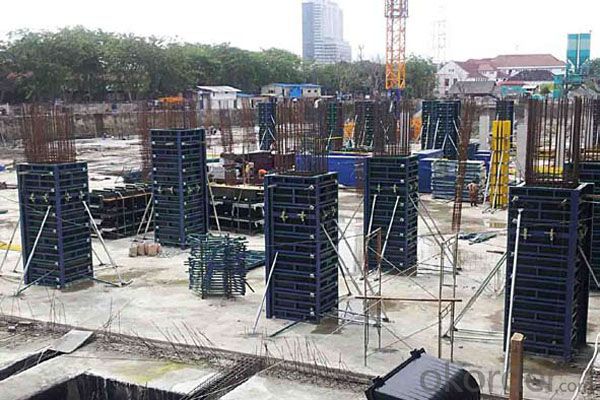
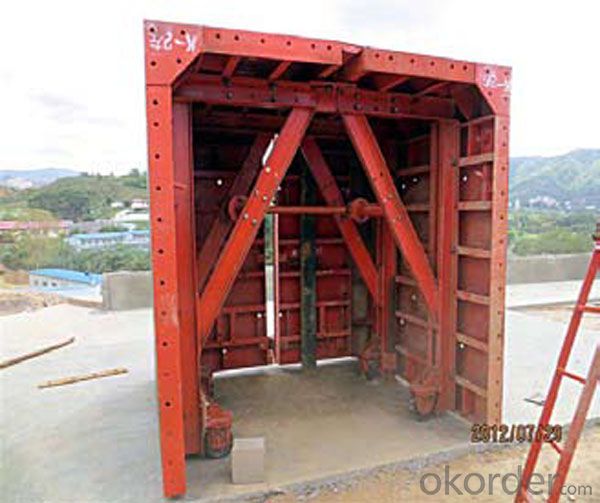
Product description:
Name: | RingLock Scaffold System |
Category: | Scaffolding System |
Material: | Steel (Q235/Q345) |
Size: | D48*3.25mm, etc |
Surface: | Electro Galvanized, Hot Dipped Galvanized, Painted, Powder Coated |
Component: | Standard, Ledger, Diagonal Brace, Bracket, Base Jack, U Head Jack, Etc. |
Application: | Slab Support, Staircase, Stage Plateforms, Bridge Support, Mobile Tower, etc. |
Manufacturer: | OEM is Available |
Items or goods can be manufactured according to your standards. | |
Advantage
* Good loading capacity
* Easy to assemble and dismantle
* Excellent quality for formwork & scaffolding with wide choices
Other scaffolding & formwork products:
(1) Scaffolding System:
(2) Scaffolding Frame & Accessories:
(3) Scaffolding Couplers/Clamps:
(4) Formwork System Scaffolding & Accessories:
Company introduce and advantages:
1. A state-owned company, prestige fi rst.
2. One of Fortune 500 companies in the world. No. 5 in the building material fi eld.
3. Six Sigma strategy , which means no more than 3.4 defects existing among one million of error
possibilities.
4. In line with the business, we launched E-business platform Okorder.com.
5. We are highly recognized by our business partners and clients all over the world and has obtained rapid
development under the spirit of win-win.
FAQ
Why Us?
We are one of the largest construction materials suppliers in China.
We own professional manufacturers with powerful producing capacity.
Extensive and comprehensive quality control system
Excellent products with competitive prices.
Efficient services in pre and after sale.
Full energy with affluent experience team.
- Q:Can steel frame formwork be easily dismantled and recycled?
- Yes, steel frame formwork can be easily dismantled and recycled. Steel is a highly recyclable material, and steel frame formwork is designed in a way that allows for easy disassembly. The formwork system typically consists of modular steel frames and panels that can be easily removed and reconfigured for future construction projects. Once dismantled, the steel frame formwork can be sent to a recycling facility where it can be melted down and reused to produce new steel products. This recycling process helps in reducing waste and conserving natural resources, making steel frame formwork a sustainable and environmentally friendly choice in construction.
- Q:Can steel frame formwork be used in areas with limited access?
- Yes, steel frame formwork can be used in areas with limited access. Steel frame formwork is known for its versatility and adaptability, making it suitable for various construction projects, regardless of the accessibility of the area. Its modular design allows for easy transportation and assembly, enabling it to be used in tight spaces or areas with limited entry points. Additionally, steel frame formwork can be dismantled and reassembled quickly, making it ideal for projects in areas where access is restricted or challenging.
- Q:Does steel frame formwork require any specific training for installation?
- Yes, steel frame formwork does require specific training for installation. Steel frame formwork is a complex system that involves precise assembling and installation processes. To ensure the safety and effectiveness of the formwork, it is crucial for the installers to have the necessary knowledge and skills. Training for steel frame formwork installation typically includes learning how to read and understand technical drawings and specifications, as well as familiarizing oneself with the different components and materials used in the formwork system. Installers are trained on proper handling, lifting, and positioning of the steel frames, as well as the correct methods for connecting and securing the formwork panels and accessories. Additionally, training covers important safety procedures and measures to be followed during installation, such as the use of personal protective equipment and ensuring stability and stability of the formwork structure. It is also important to understand the load capacities and limitations of the steel frame formwork system to prevent any potential accidents or structural failures. Overall, specific training for steel frame formwork installation is essential to ensure that the formwork is installed correctly, meets the required standards and specifications, and provides a safe and stable support for concrete construction projects.
- Q:How does steel frame formwork ensure proper ventilation during concrete curing?
- Steel frame formwork does not directly ensure proper ventilation during concrete curing. However, it can indirectly contribute to ventilation by providing sufficient space between the formwork panels and the concrete surface. This gap allows air to circulate and facilitates the evaporation of excess moisture during the curing process. Additionally, steel frame formwork may incorporate strategically placed holes or slots to further enhance airflow and promote proper ventilation. However, it is important to note that the primary responsibility for ensuring proper ventilation during concrete curing lies with the overall construction design, including the use of proper curing techniques and adequate provision of ventilation openings in the formwork system.
- Q:How does steel frame formwork contribute to the overall thermal insulation of a concrete structure?
- The thermal insulation of a concrete structure is not directly affected by steel frame formwork. The main purpose of steel frame formwork is to provide temporary support and shape to the concrete during the pouring and curing process. Its primary function is to guarantee the concrete's structural integrity and achieve the desired shape and dimensions. However, there are other methods to enhance the overall thermal insulation of a concrete structure. For example, insulation materials like polystyrene boards, foam concrete, or expanded polystyrene (EPS) blocks can be incorporated into the design to improve its thermal performance. These materials are typically placed between the concrete walls or slabs, acting as a barrier against heat transfer and reducing thermal bridging. Moreover, additional elements such as double-glazed windows, high-performance insulation coatings, and proper sealing techniques can be utilized to further boost the thermal insulation of the concrete structure. These measures help minimize heat loss or gain through the building envelope, resulting in improved energy efficiency and reduced heating or cooling demands. Although steel frame formwork does not directly contribute to thermal insulation, it plays a vital role in ensuring the structural integrity of the concrete structure, which indirectly impacts the overall energy efficiency and sustainability of the building.
- Q:What are the different types of formwork insulation solutions available for steel frame formwork systems?
- There are several types of formwork insulation solutions available for steel frame formwork systems. Some common options include rigid foam insulation boards, spray foam insulation, insulated concrete forms (ICFs), and thermal blankets. Each solution offers different levels of thermal resistance and installation methods, allowing for flexibility in meeting specific project requirements.
- Q:How does steel frame formwork handle the placement of reinforcement bars within the concrete structure?
- Steel frame formwork is specifically designed to handle the placement of reinforcement bars within a concrete structure. The formwork system consists of steel panels that are connected together to create a sturdy framework, which serves as a mold for pouring concrete. One of the main advantages of steel frame formwork is its flexibility in accommodating reinforcement bars. The steel panels can be easily adjusted and positioned to create the desired shape and dimensions of the concrete structure, allowing for the precise placement of reinforcement bars. This is crucial for ensuring the structural integrity and strength of the concrete. The steel frame formwork also has various features that assist in the placement of reinforcement bars. For example, it may include pre-drilled holes or slots in the steel panels, which allow for the insertion and secure positioning of the bars before pouring the concrete. Additionally, the formwork system can incorporate special accessories such as spacers or brackets that help to maintain the correct spacing and alignment of the reinforcement bars within the concrete structure. Furthermore, steel frame formwork provides excellent support and stability during the pouring and curing process. The rigid steel framework holds the reinforcement bars in place, preventing any displacement or movement that could compromise the structural integrity of the concrete. This ensures that the bars remain in their intended positions and are fully encapsulated by the concrete, maximizing their effectiveness in reinforcing the structure. In summary, steel frame formwork is specifically designed to handle the placement of reinforcement bars within a concrete structure. Its flexibility, adjustability, and stability make it an ideal choice for ensuring the accurate positioning and effective reinforcement of the bars, ultimately contributing to the overall strength and durability of the concrete structure.
- Q:What is the maximum load capacity of steel frame formwork?
- The maximum load capacity of steel frame formwork can vary depending on various factors such as the design, dimensions, and quality of the steel used. However, in general, steel frame formwork is known for its high load-bearing capacity. It is designed to withstand heavy loads during concrete pouring and formwork support. Typically, steel frame formwork can handle load capacities ranging from 60 to 100 kilonewtons per square meter (kN/m²). This load capacity allows it to support the weight of concrete, reinforcement, and any additional loads applied during construction. It's important to note that the load capacity can be influenced by factors like the thickness of the steel frames, the spacing of the supports, and the quality of the welds. Additionally, the load capacity may also depend on the specific application and the engineering calculations performed for that particular project. Therefore, it is crucial to consult the manufacturer's specifications and guidelines to determine the maximum load capacity of a specific steel frame formwork system. Additionally, consulting with a structural engineer or a qualified professional can provide more accurate information regarding the load capacity based on the specific project requirements.
- Q:Can steel frame formwork be used for both straight and curved beams?
- Steel frame formwork is suitable for both straight and curved beams. This versatile system can be adjusted and tailored to fit various shapes and sizes of beams. It ensures a stable and rigid structure, guaranteeing proper pouring and support of the concrete. The steel frames can be effortlessly assembled and dismantled, providing flexibility for creating both straight and curved beams. Moreover, steel frame formwork boasts exceptional strength and durability, making it ideal for construction projects that demand both types of beams.
- Q:Are there any specific considerations for using steel frame formwork in coastal areas?
- Yes, there are specific considerations for using steel frame formwork in coastal areas. The primary concern is corrosion due to the high salt content in the air and water. Special corrosion-resistant coatings or stainless steel should be used to prevent the steel frame from deteriorating. Additionally, the formwork should be designed to withstand the strong winds and potential impact from waves or debris in coastal areas. Regular maintenance and inspections are also necessary to ensure the structural integrity of the steel frame formwork in these harsh environments.
1. Manufacturer Overview |
|
|---|---|
| Location | |
| Year Established | |
| Annual Output Value | |
| Main Markets | |
| Company Certifications | |
2. Manufacturer Certificates |
|
|---|---|
| a) Certification Name | |
| Range | |
| Reference | |
| Validity Period | |
3. Manufacturer Capability |
|
|---|---|
| a)Trade Capacity | |
| Nearest Port | |
| Export Percentage | |
| No.of Employees in Trade Department | |
| Language Spoken: | |
| b)Factory Information | |
| Factory Size: | |
| No. of Production Lines | |
| Contract Manufacturing | |
| Product Price Range | |
Send your message to us
Steel Formwork System Fromwork Accessories
- Loading Port:
- Tianjin
- Payment Terms:
- TT OR LC
- Min Order Qty:
- 3 m.t
- Supply Capability:
- 1000 m.t/month
OKorder Service Pledge
OKorder Financial Service
Similar products
New products
Hot products
Related keywords
